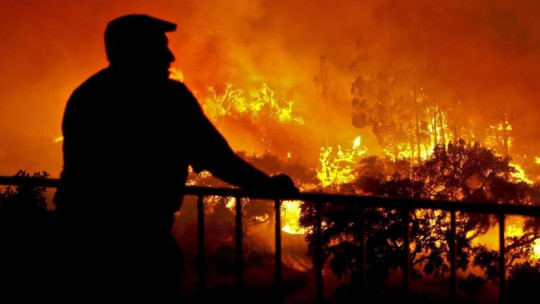Pyros. This Greek word refers to one of the four primordial elements of nature for the Greeks, fire. This element has presented an interesting dichotomy throughout history, being able to symbolize energy, dynamism, heat, affection and passion, but also hatred, destruction and madness.
Since ancient times, fire has been an element that has caused great fascination and respect. However, some people have an excessive fixation on it needing to provoke it in order to calm their tension and anxiety, calming their impulses regardless of the serious effects it may cause on the environment or other people or animals. These people suffer from the disorder known as pyromania.
Pyromania: an impulse control disorder
Pyromania is an impulse control disorder which are characterized by the presence of an uncontrollable need to carry out a harmful or illegal act, without taking into account its repercussions. In this type of disorder, a high level of tension suddenly appears that they need to relieve by committing the act in question, after which they feel a high level of well-being. This process is largely reminiscent of that seen in anxiety disorders, dependency and other substance abuse disorders, or obsessive-compulsive disorder.
In the case of pyromania, the diagnosis is carried out in individuals who have deliberately started fires on more than one occasion, feeling tension before starting it and producing a high feeling of well-being after the start of the fire or after seeing its consequences. . The provocation of the fire is not due to the pursuit of an economic, personal or social benefit. These individuals always have a high fascination with observing flames.
What pyromania is and what it is not
The fact that a human being causes a fire can be due to a large number of causes. For example, unintentional fires can and often do occur due to uncivil actions or carelessness such as leaving flammable materials, cigarette butts or bottles in areas with vegetation. In this case we would not be faced with a case of pyromania, since its diagnosis requires that the fire be intentional.
One of the most confusing labels that is often confused with pyromania is arsonist. Arsonists are those individuals who, like arsonists, deliberately cause a fire, but unlike the latter, they do so with a clear objective, pursuing a specific benefit or causing damage to another person or institution.
The production of fire due to other mental disorders such as schizophrenia, mania, dementia or substance intoxication is also not considered pyromania, nor are fires set by subjects with antisocial personality disorder (or dissocial in children).
Arsonist profile
Although all people are different from each other, there are great individual differences that mark one’s own identity, common patterns can often be observed between different subjects. This happens both at the non-clinical population level and at the clinical level.
In the case of individuals who suffer from pyromania or arsonists, it is possible to consider the existence of a typical profile. Around 90% of individuals who suffer from pyromania are young men. who tend to suffer from emotional problems and usually have a history full of frustrations on a personal level, often with a certain level of resentment because of it.
In this disorder, the presence of an unsociable personality prevails, as well as an IQ below average (although this is not true in all cases). These are subjects with a high level of frustration, a feeling of existential emptiness, a high sense of inferiority who present feelings of little control, power or worth, which they try to replace with the empowerment felt when starting the fire.
It is also common that these subjects come from unstructured families. in those who have suffered mistreatment and/or sexual abuse in childhood. In the same way, the complete absence of a father figure is observed in many cases.
At an occupational level, their great attraction to fires drives arsonists to try to get involved in jobs related to or from which they have access to their object of stimulation, fire. In this way, it is common for them to try to join fire departments, or even participate as volunteers in firefighting tasks. It is common that many of them end up helping to put out the fires that they themselves cause, as a way of being able to observe first-hand the effects of the flames.
Pyromaniac behaviors are, along with the abuse and mutilation of animals and extremely violent actions and lack of empathy, possible indicators of psychopathy.
Etiology (causes) of the disorder
There are multiple possible causes of this disorder.
At a psychological level, it is considered that the presence of a high level of sensation seeking together with the need for power and attention derived from a lack of social contact and skills to create or maintain bonds with others, can cause pyromania. Setting fires has also been considered as a way to express deep feelings such as anger at the feeling of inferiority. Finally, parenting models in which violence, abuse and neglect of the child abound, or traumatic experiences such as sexual abuse in childhood, can also lead to this type of disorder.
At a neurobiological level, it has been correlated, like the rest of impulse disorders, with the presence of low levels of serotonin at the brain level, as well as dysregulation in dopamine and norepinephrine. The presence of hypoglycemia has also been observed in many arsonist individuals.
Likewise, the temporal lobe and the limbic system have some participation in this disorder, due to the management of impulses and emotions. The frontal lobe and orbitofrontal cortex are also involved, failing in the process of inhibiting behavior.
Possible treatments
Pyromania is a rare disorder. His treatment has focused predominantly on cognitive-behavioral therapy, although treatments have been carried out from other theoretical aspects, such as psychodynamics.
The treatment in question is based on promoting impulse control and self-control. through behavior modification techniques, conflict resolution techniques, self-detection of the level of tension and the application of relaxation techniques such as breathing. These techniques promote the individual to be more capable of coping with problems, but for the treatment to be efficient, the patient’s empowerment must also be worked on, helping to work on self-image and self-esteem, as well as personal interactions. Working on empathy can also be useful.
It must be taken into account that the arsonist does not usually go to the consultation on his own, being generally led to do so by relatives of the patient or by court order, since the majority do not usually show remorse for their actions despite being aware of the danger they entail. Likewise, it is of great importance to carry out prevention tasks from childhood.









